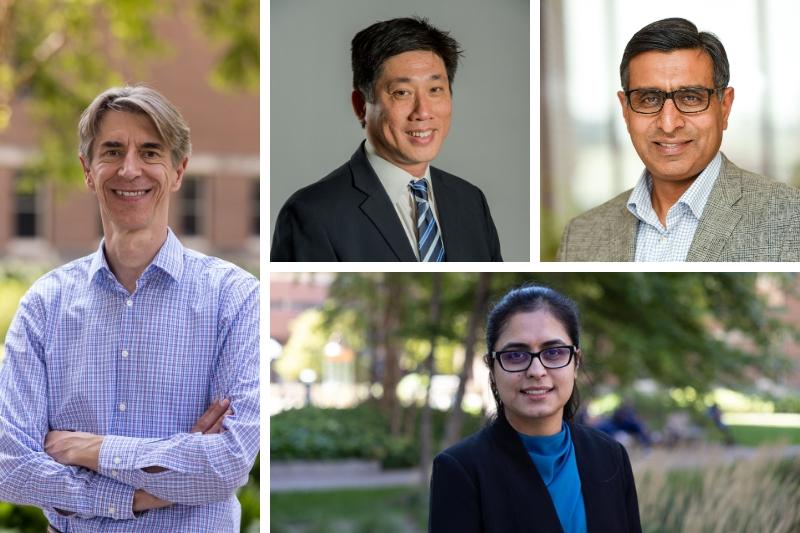Researchers, clinicians come together to solve patient problems with collaborative grant

Four School of Dentistry faculty members received Clinical and Basic Science Faculty Collaborative Pilot Grants through the Office of Research and Discovery.
The School of Dentistry-funded program aims to establish collaborations between clinical and basic science faculty, opening new research directions.
Thorsten Gruenheid, DDS, Dr med dent, PhD, MHA, associate professor of orthodontics, and Alex Fok, PhD, MSc, director of the Minnesota Dental Research Center for Biomaterials and Biomechanics, received a grant for their work developing computational models for orthodontic aligners and improving the ability of remote monitoring of aligners. They are joined in their collaboration by Susan Mantell, PhD, a mechanical engineer in the College of Science and Engineering.
More specifically, “we want to develop a system that allows patients and clinicians to remotely monitor the surface strains of clear aligners using photos taken with personal cell phones,” explained Gruenheid. “We will use validated finite element models to establish the correlation between the aligner surface strains and the forces and movements on the teeth.”
“The idea of applying remote monitoring from engineering to teledentistry was the inspiration behind this grant,” explained Fok, who is a leader in the development of biomaterials. “We aim to develop tools that are useful for orthodontists in the planning and implementation of treatments. It is important for the engineers to collaborate with clinicians to better understand clinical problems, and what the research needs are.”
Gruenheid appreciates the ability to work with researchers from other fields. “As clinicians, we have well-defined skill sets. Similarly, basic science researchers have well-defined
skill sets. However, these skill sets rarely overlap,” he explained. “I believe that bringing these different skills together can create true synergies, which may result in something that is greater than the sum of its parts.”
Gruenheid and Fok will use the grant for a pre-clinical feasibility study and to validate models that they developed in the lab. “Once that step has been taken, we can translate the system into the clinic and bring it into application in patient care,” said Gruenheid.
After the pilot study, the researchers hope their work will lead to “the realization of tele-orthodontics,” in Fok’s words. And perhaps most importantly, this work will have a measurable impact on patient care.
“Much of the innovation in the field of orthodontics is driven by business and industry,” explained Gruenheid. “As a result, some innovations prioritize the interests of companies and their shareholders over those of clinicians and patients. Independent research such as ours allows us to put the patient back at the center of what we do, develop more precise and efficient care methods, and help shape the future of the specialty.”
Rajaram Gopalakrishnan, BDS, PhD, professor and director of the Division of Oral and Maxillofacial Pathology, and Isha Mutreja, PhD, MSc, assistant professor of biomaterials, received a grant to support their work toward developing an “oral mucosal bandage” to deliver medication that stops the progression of pre-cancerous to cancerous lesions.
“Oral cancer is difficult to treat, requiring extensive surgery and sometimes chemo and radiation treatment. Because these tumors arise close to vital blood vessels, nerves and the brain, current treatments often result in poor outcomes and may cause considerable facial disfigurement,” explained Gopalakrishnan. “In most patients, oral cancer has a precursor stage. We want to produce local intervention strategies to effectively target the pre=cancerous or early invasive stages prior to progression to a more extensive invasive disease.”
The grant will allow the researchers to undertake a pilot study, gaining data that can be used to apply for federal funding.
In their pilot study, Gopalakrishnan and Mutreja hope to target monocarboxylate transporter 1, which “is responsible for the transport of important metabolites in and out of a cell.”
Gopalakrishnan has seen first-hand the effects of oral cancer in his role as an oral pathologist. “My long term goal is to understand the mechanisms that control transformation of precancerous lesions to cancer so that we can effectively develop strategies to block this transformation,” he said. Mutrjea, a materials scientist, spends her time creating “multifunctional platforms for biomedical applications.”
“To see the materials we are working on in the lab make their way to the clinic is exciting, but that is only possible if there is a constant dialogue between the basic scientists and clinicians,” she explained. “This particular collaboration provides me with an exciting opportunity to understand the challenges clinicians face when treating conditions, and use that as a benchmark to propose a solution.”
This sense of collaboration and the improvement of outcomes is a key goal across the board–and one that was part of the impetus for the grant program in the first place. With the results of these pilot trials, researchers and clinicians hope to come together to fulfill the mission of the Office for Research and Discovery: promoting scientific discovery that impacts everyday lives.